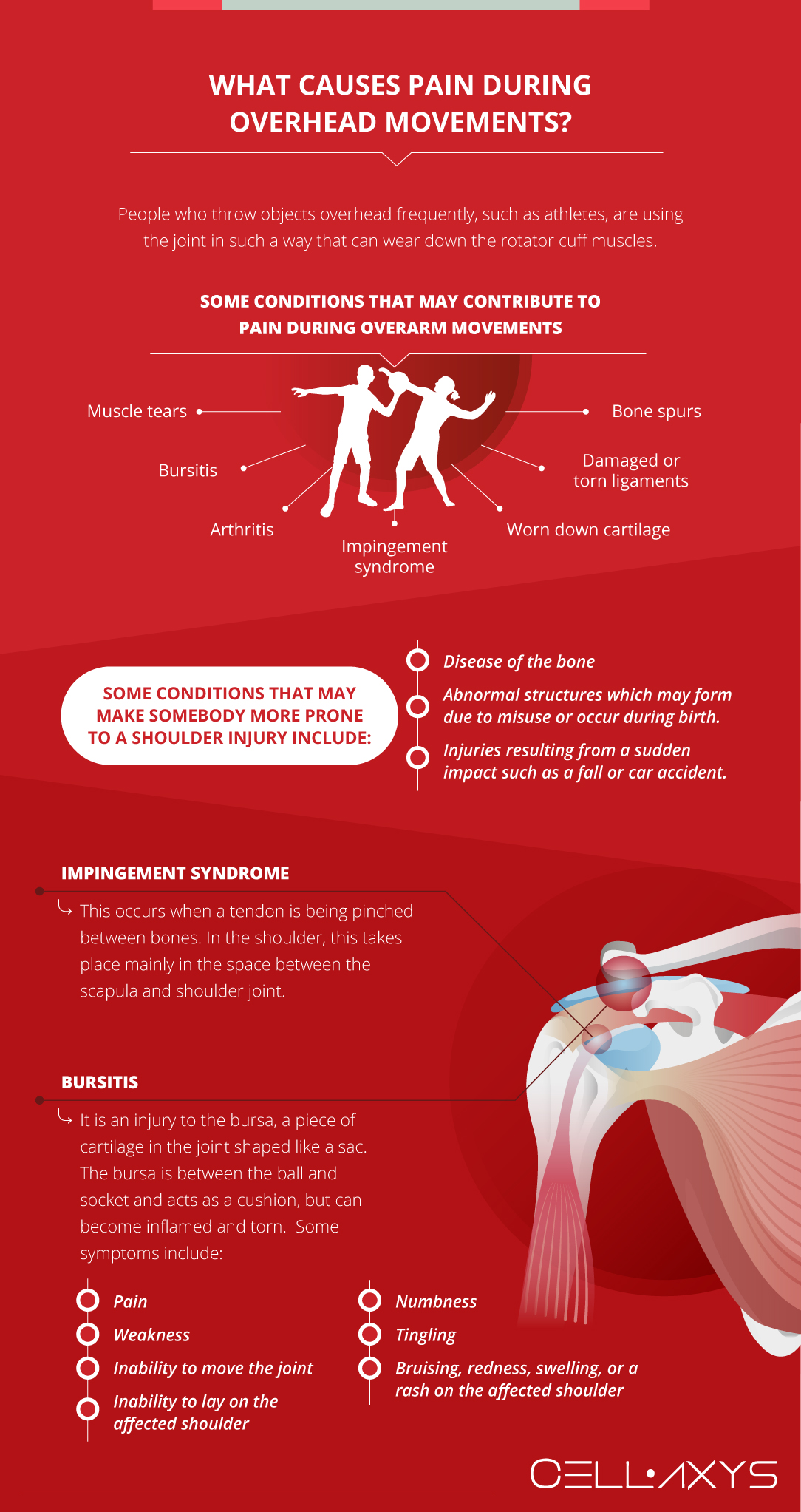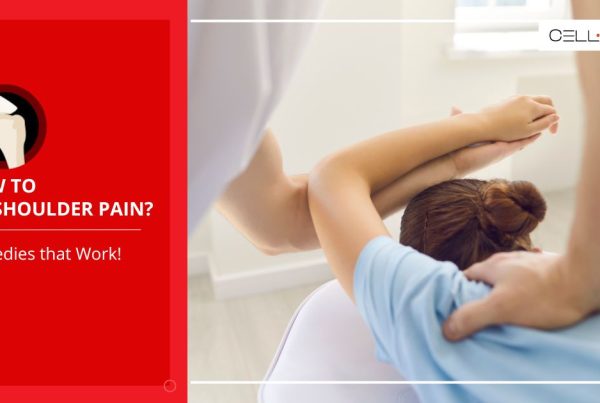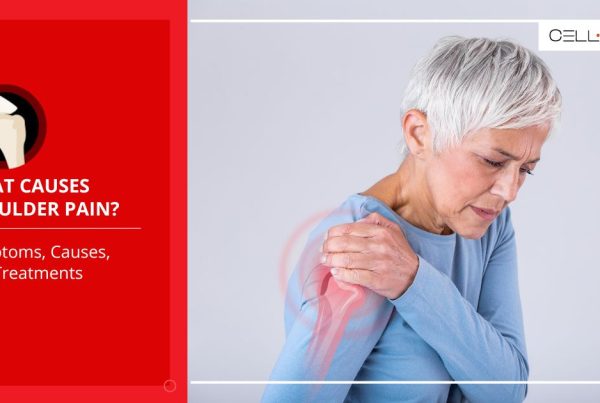Published on: April 20, 2020 | Updated on: August 29, 2024
Many cases of pain during the overarm movement can be attributed to either overuse of the shoulder joint, or natural degeneration of soft tissue. There are many ways in which a shoulder can become injured due to its complex nature and the many small components that make up the joint.
Due to this, there are many treatment options and processes that can ease the associated symptoms.
Anatomy of the Shoulder
The shoulder joint is a ball and socket joint, meaning that the head of the arm bone (humerus) fits into a concave portion of the shoulder blade. Between these two structures is strong, fibrous cartilage that protects their joint. This cartilage also allows the joint to glide smoothly, giving the shoulder a wide range of motion.
Ball-and-socket joints need a vast network of soft tissue such as muscles, cartilage, and tendons to support the joint. This shape of the joint is prone to dislocate, and the frequently-used location means that a lot of stress can be placed on the soft tissue.
A rotator cuff is a group of muscles originating on the shoulder blade that allows the joint to have the range of motion that it does. The structure of a ball-and-socket joint is less stable by nature than other joints in the body. This means that muscle groups such as the rotator cuff are extremely important in maintaining the structure and stability of the shoulder.
There are four major muscles in the rotator cuff:
- Supraspinatus: Located at the top of the joint, above the shoulder blade. It is attached to the top of the humerus.
- Infraspinatus: Located on the outside of the shoulder blade, attached to the top of the humerus.
- Teres minor: Located closer to the bottom of the shoulder blade, slightly under the Infraspinatus. It is attached to the bottom portion of the ball part of the joint.
- Subscapularis: Located under the shoulder blade, providing much of the support needed to support the shoulder from the inside.
Each of these muscles plays an important role in the motion of the shoulder. They are also associated with separate nerves, which send the signals needed to use these muscles. Any of these nerves and muscles can become damaged or injured. There are many potential causes of injury to the soft and hard tissues of the shoulder joint.
Some other (non-rotator cuff) muscles in the shoulder to keep in mind are the deltoid, located at the top of the arm, and the trapezius at the base of the neck and down the spine.
What Causes Pain During Overhead Movements?

A shoulder injury can occur to anyone at any time, but some individuals are at a greater risk of injuring their shoulders than others. People who throw objects overhead frequently, such as athletes, are using the joint in such a way that can wear down the rotator cuff muscles. Throwing uses almost all of the muscles in the joint because it’s moving the arm in almost all of the ways it can possibly move therefore activating and engaging many different muscles and tendons.
Some conditions that may contribute to pain during overarm movements are:
- Muscle tears
- Bursitis
- Arthritis
- Impingement syndrome
- Damaged or torn ligaments
- Worn down cartilage
- Bone spurs
Some conditions that may make somebody more prone to a shoulder injury include diabetes, arthritis, disease of the bone, and abnormal structures which may form due to misuse or occur during birth. Injuries resulting from a sudden impact such as a fall or car accident may also contribute to shoulder pain.
Impingement syndrome occurs when a tendon is being pinched between bones. In the shoulder, this takes place mainly in the space between the scapula and shoulder joint. Bursitis is an injury to the bursa, a piece of cartilage in the joint shaped like a sac. The bursa is between the ball and socket and acts as a cushion, but can become inflamed and torn.
Bursitis occurs when the structures of the joint are not functioning properly. This can lead to many symptoms for the individual, including:
- Pain
- Weakness
- Inability to move the joint
- Inability to lay on the affected shoulder
- Numbness
- Tingling
- Bruising, redness, swelling, or a rash on the affected shoulder
Symptoms may occur only during certain activities or be more persistent. The location and duration of pain can vary from one individual to the next – when seeking treatment, it is important to discuss all of the sensations and symptoms that are occurring.
Diagnosing shoulder pain begins with a visit to a medical professional who can examine the joint and how it functions. They will observe the particular movement that causes pain and ask questions to further determine why it hurts. Imaging technology such as MRI or X-ray can help guide doctors to damaged tissue or structural abnormalities.
Treating Shoulder and Arm Pain at Home
Once the cause of pain is diagnosed, patients and doctors can devise a treatment plan that is individualized to meet each patient’s needs.
Many soft tissue injuries like impingement and tears can heal on their own over time. Treatment for minor injuries consists of managing pain and sometimes physical therapy.
Pain management can be achieved with anti-inflammatory drugs such as ibuprofen. Using ice and heat as recommended can also help to relieve inflammation, stiffness, and pain. Some patients also use corticosteroid injections for pain relief. These injections are not recommended for everyone, as they can damage soft tissue over time.
Physical therapy can result in significant pain relief in some patients. Trained physiotherapists use certain exercises to restore a range of motion and strengthen muscles that may have grown weak. Some muscles can atrophy if they are not being used – to prevent further atrophy, it is necessary to retrain the muscles. Some exercises may require certain equipment, but there are many at-home practices to learn that can improve quality of life.
Just a few of these at-home exercises include:
- Cross arm stretch: Extend your injured arm out in front of you, shoulder-length high, at a 90-degree angle from the floor. Then, bring the arm across the chest and use your other arm to increase the stretch. Bring your stretched arm across your body as far as comfortably possible. Hold this position for 30-60 seconds before letting go. Do this stretch a few times per day.
- Pendulum: Start by bending over a table or chair while supporting your non-injured arm. Draw circles in the air with the painful arm dangling straight down. The circles should begin tiny and progressively develop in size, with frequent rotations in the opposite direction. Do this 5-10 times during the day.
- Neck rotation: Slowly tilt your chin toward your chest while sitting up straight until you feel a stretch at the back of your neck. Then tilt your head to the left to stretch your right shoulder, or to the right to stretch your left shoulder. On each side, hold the stretch for 30-60 seconds. Deep breathing can help you relax and get the most out of your stretch.
- Chest stretch: You will need an exercise band, strap, tie, or rope for this workout. Place one of these items behind your back, both hands holding it. Lift your chin toward the ceiling while moving your shoulder blades toward one another. While inhaling deeply, continue for 10-15 seconds. Repeat this 3-5 times more.
These exercises can be effective but for severe pain and injury, they may not be enough. Depending on the cause of shoulder pain, the treatment journey may lead to surgery. Doctors will often begin with minor surgery when possible. Arthroscopy is performed with a tiny camera and tiny tools that can make small repairs to the joint. More extreme cases could result in partial or even total shoulder replacement surgery.
Replacement surgeries can be a difficult process because there are many positive and negative aspects to consider. Preparing for surgery can ease some of this anxiety – though many patients may prefer a non-surgical treatment.
Alternative Ways to Treat Arm and Shoulder Pain
Many causes of arm pain include damage to soft tissue. In many patients, there is more than one injury occurring simultaneously – some damage can cause the muscles to overcompensate and tear, bones can rub against one another if the bursa is damaged, and so on.
Muscles are good at repairing themselves, but some tissues of the shoulder joint are more difficult to treat. The emerging field of regenerative medicine treats shoulder pain caused by these hard-to-treat injuries.
There are two types of regenerative therapies performed at CELLAXYS — platelet-rich plasma (PRP) therapy and cell-based therapies.
Platelet-Rich Plasma Therapy
Platelet-rich plasma (PRP) therapy uses platelets in a patient’s blood to increase the number of healing cells in an injured area. A blood sample is drawn from the patient and then processed to isolate platelets from the blood plasma. These platelets are then reinjected into the patient’s injury site to promote healing.
Platelets are healing bodies in our blood that contain 10 Growth Factors to stimulate the development of healthy tissues. They also release chemical signals to attract healing cells in the blood and produce a sticky, web-like structure called fibrin that provides the foundation for the new tissues to develop.
PRP is a popular treatment for several spine, orthopedic, and sports injuries. The process takes about 45 minutes to complete and is an outpatient procedure, meaning you can go home after the process.
Cell-Based Therapies
More commonly known as stem cell therapies, this treatment uses a patient’s own cells or “autologous tissues,” fortifies them, and then injects them into the injury site to speed up the recovery process.
Depending on your condition, the doctor may opt for one of the two types of cell-based therapies:
- Minimally Manipulated Adipose Tissue (MMAT) transplant: It involves replacing the damaged cells with the patient’s adipose (fat) tissue. The doctor can perform MMAT in different locations in the same procedure.
- Bone Marrow Concentrate (BMAC): It replaces the damaged cells with highly concentrated cells from your bone marrow.
Both cell-based therapies take about 1.5 to 2 hours to complete. Like PRP, they are outpatient procedures. The doctor uses a live X-ray or ultrasound to detect the exact transplant location.
Doctors will look at a patient’s whole profile and experience with injury to determine what treatments are best for them. These treatments can relieve persistent arm pain, but they perform even better if accompanied by treatments such as physical therapy.
Sources
Footnotes
- Seroyer ST, Nho SJ, Bach Jr BR, Bush-Joseph CA, Nicholson GP, Romeo AA. Shoulder pain in the overhead throwing athlete. Sports health. 2009;1(2):108-20.
- NEVIASER RJ. Painful conditions affecting the shoulder. Clinical Orthopaedics and Related Research. 1983;173:63-9.
- Herberts P, Kadefors R, Högfors C, Sigholm G. Shoulder pain and heavy manual labor. Clinical Orthopaedics and Related Research (1976-2007). 1984;191:166-78.
- Sakakibara H, Miyao M, Kondo TA, Yamada SY. Overhead work and shoulder-neck pain in orchard farmers harvesting pears and apples. Ergonomics. 1995;38(4):700-6.
- Wilk KE, Obma P, Simpson CD, Cain EL, Dugas J, Andrews JR. Shoulder injuries in the overhead athlete. Journal of orthopaedic & sports physical therapy. 2009;39(2):38-54.
- Pountos I, Panteli M, Walters G, Bush D, Giannoudis PV. Safety of epidural corticosteroid injections. Drugs in R&D. 2016;16:19-34.
References
- Shoulder Pain with Overhead Arm Motions. Texas Children’s. Accessed 2/23/2024.
- Overhead Work – Reduce the Injury Risk. University of Waterloo. Accessed 2/23/2024.
- Rotator Cuff Tears. OrthoInfo. Accessed 2/23/2024.
- Arthroscopy. Mayo Clinic. Accessed 2/23/2024.
- Bursitis. Mayo Clinic. Accessed 2/23/2024.
CELLAXYS does not offer Stem Cell Therapy as a cure for any medical condition. No statements or treatments presented by Cellaxys have been evaluated or approved by the Food and Drug Administration (FDA). This site contains no medical advice. All statements and opinions are provided for educational and informational purposes only.
Dr Pejman Bady
Author
Dr. Pejman Bady began his career over 20 years ago in Family/Emergency Medicine, working in fast-paced emergency departments in Nevada and Kansas. He has served the people of Las Vegas as a physician for over two decades. Throughout this time, he has been met with much acclaim and is now the head of Emergency Medical Services in Nye County, Nevada. More about the doctor on this page.
Dr Pouya Mohajer
Contributor
Pouya Mohajer, M.D. is the Director of Spine and Interventional Medicine for CELLAXYS: Age, Regenerative, and Interventional Medicine Centers. He has over 20 years of experience in pain management, perioperative medicine, and anesthesiology. Dr. Mohajer founded and is the Medical Director of Southern Nevada Pain Specialists and PRIMMED Clinics. He has dedicated his career to surgical innovation and scientific advancement. More about the doctor on this page.









